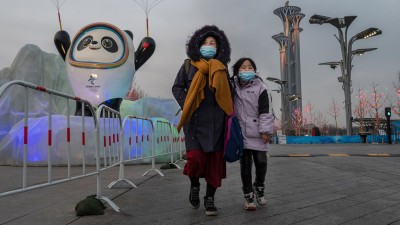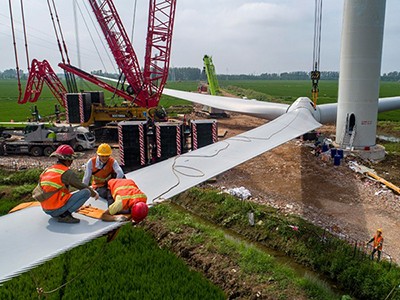China’s Winter Olympics are carbon-neutral — how?
Researchers commend Beijing for mitigating a wide range of emissions, but say that future games should wean themselves off carbon offsets.
Smriti Mallapaty
The Winter Olympics begin today in Beijing, a spectacle that will see 3,000 athletes compete in 109 events, from curling to speed skating. The event also claims two firsts: Beijing becomes the only city to have hosted both a summer and a winter games. And, China says, this Olympics will be the first to be carbon neutral.
The pandemic and the nation’s COVID-19 restrictions have helped in this effort, because few spectators can attend, but China has also saved emissions by retrofitting buildings from the 2008 summer games, using renewable power and procuring vehicles fuelled by hydrogen, natural gas and electricity.
“We are very confident that we will be a truly carbon-neutral games,” says Liu Xinping, who is in charge of sustainability for the Beijing Organising Committee for the 2022 Olympic and Paralympic Winter Games. Offsets greater than the games’ likely footprint have also been secured, Liu adds.
Previous Winter Olympics have claimed to be carbon neutral, but the International Olympics Committee (IOC) says that China is considering a much broader range of emissions. It has already been investing heavily in renewable energy as part of its overall goal of achieving carbon neutrality by 2060.
The games’ estimated footprint, equivalent to 1.3 million tonnes of carbon dioxide, is a drop in the ocean compared with China’s annual emissions of about 11 billion tonnes, but the value of its achievement is “in demonstrating that broader carbon-neutral activities are possible”, says Michael Davidson, an energy systems researcher at the University of California San Diego.
Although some researchers commend Beijing’s efforts, others take a more sceptical view of claims made by host nations of the Olympics. Some point out that, even with China’s efforts to keep emissions low, it still needs to offset emissions equivalent to that produced by about 220,000 cars in a year.
Retrofitting sports venues
The games are taking place in the capital and in the mountains of Yanqing and Zhangjiakou to the northwest. Beijing has reduced the impact of the current games by repurposing seven venues used in summer 2008 and for other sports events. For example, the Water Cube has been converted into a curling rink called the Ice Cube.
The organizing committee also says that all of the 13 newly constructed buildings have received the highest rating under a Chinese green-building certification system; another five are temporary structures that will have a limited carbon footprint.
One unexpected windfall came from the pandemic. China’s zero-tolerance approach to COVID-19 means that is not allowing international spectators; it has also cancelled local ticket sales. As a result, more than 500,000 tonnes of CO2 have been saved that would otherwise have been generated by the travel and accommodation sectors.
These Olympics are also the first to use natural CO2 as a refrigerant to cool the skating venues, instead of synthetic hydrofluorocarbon refrigerants, saving up to 26,000 tonnes of carbon. Claudio Zilio, who studies refrigerants at the University of Padua, Italy, says that CO2 is an environmentally friendly option for the purpose, but that the promised saving “seems very high”.
Yanqing and Zhangjiakou — where snow sports including skiing and snowboarding will be held — are cold in winter, but have very little precipitation, so China has had to pump in water from other regions to manufacture snow.
Running the games will consume 2.8 million cubic metres of water — enough to fill 1,000 Olympic-sized pools. But the organizing committee says that the games will use much less than 10% of the water resources of the Yanqing and Zhangjiakou regions, and that the impact of pumping water to create snow will produce no more than 3,000 tonnes of CO2.
Renewable energy and offsets
Another first for an Olympics is Beijing’s commitment to source entirely renewable electricity for all 25 venues. It has redirected wind and solar energy through a newly built grid and will purchase extra green power.
However, Jules Boykoff, a political scientist at Pacific University in Oregon, and author of books on the Olympics, points out that Beijing’s electricity comes largely from coal. It is coal power that has supported construction of some of the Olympic venues, he says, and is likely to support the games themselves. “How much is the use of coal ghosting behind a lot of the now sustainable energy practices that are happening?” he asks.
Davidson adds that redirecting renewable energy to the games might be “largely an accounting exercise”, because these renewable resources might have been developed even if the games had not been happening in China. But Liu says that the wind and solar infrastructure, and the grid in Zhangbei, northwest of Beijing, were constructed specifically for the Olympics.
Even if many aspects of the games have been designed to produce minimal environmental impacts, some emissions, such as those from construction and air travel, are unavoidable. To offset these, China has planted some 60 million trees, including white birch, oak and gingko, which will mitigate around 1.1 million tonnes of CO2. Sponsors of the games have contributed carbon offsets to the value of another 600,000 tonnes.
Daniel Scott, a geographer at the University of Waterloo, in Canada, cautions, however, that reforestation can be an unreliable offset because forests can be burnt or cut down.
Future Olympic games
Nevertheless, Beijing’s winter games are the first to have considered a broad range of emissions from the earliest stages of preparation, says Marie Sallois, a director of sustainable development at the International Olympic Committee (IOC) in Lausanne, Switzerland, who is currently in Beijing. They are also the first to have taken into account indirect sources of emissions, such as air travel, she adds.
Beijing’s approach of embedding sustainability at all stages of the process is “something we will encourage for future games,” Sallois says.
Martin Müller, a human geographer at the University of Lausanne, says that relying too much on offsetting encourages a “philosophy of burn now, pay later”.
In a 2021 analysis1, he and his colleagues found that the Olympics had actually grown less sustainable over time — particularly given that the games had increased in size, resulting in a greater spectator-related footprint. He recommends scaling back events and hosting the Olympics in the same location multiple times.
Sallois says that “everything is open” to discussion and that the IOC is willing to engage in such conversations with future hosts.
Scott says that making the winter games even greener is especially crucial given the existential threat posed by a warming world. His research2 has shown that, by the end of the century, changes in temperature and snow conditions would mean that the majority of cities that have hosted any of the past 21 Winter Olympics would struggle to host another.
This means that the IOC will need to be “even more creative and flexible in how they host” future games, he says.
doi: https://doi.org/10.1038/d41586-022-00321-1
References
- 1.
Müller, M. et al. Nat Sustain 4, 340–348 (2021).
- 2.
Scott, D. et al. Current Issues in Tourism, 2022.





No comments:
Post a Comment